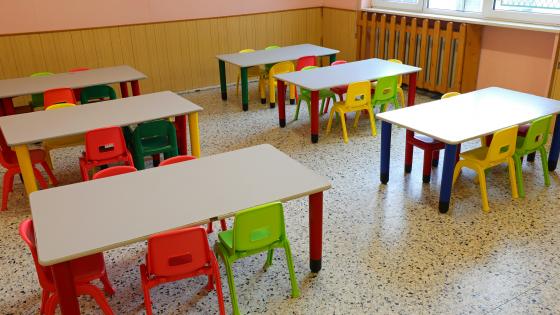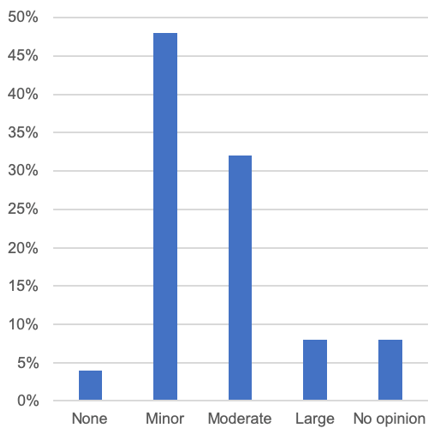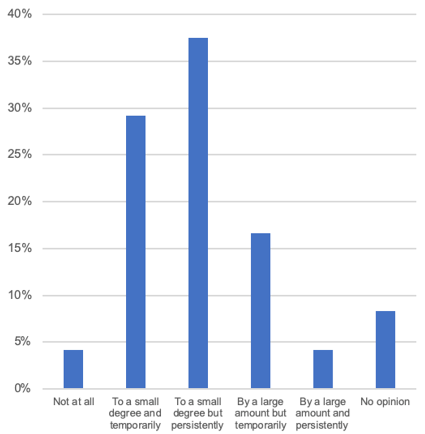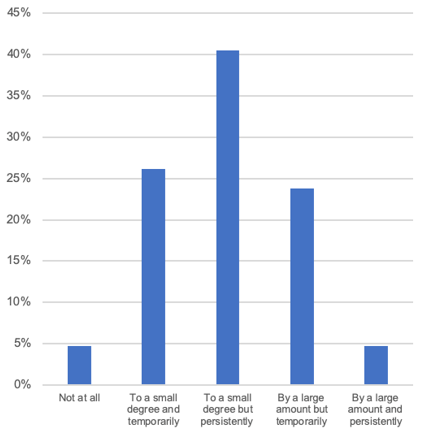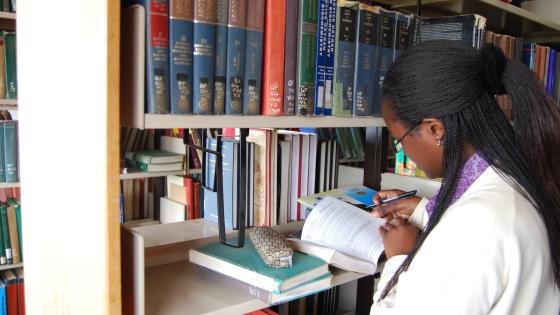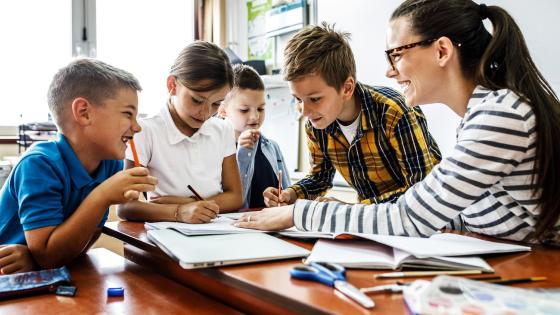Schools across the UK have been closed to most students since March 2020. They are scheduled to reopen in September, according to Department for Education guidelines, but concerns about further closures remain as a second wave of the pandemic is a distinct possibility in the autumn.
There is an open epidemiological debate on the effect of school openings on the rate of COVID-19 spread. Evidence from Saxony in Germany showed a very low infection rate for students and staff when schools reopened, although the researchers note that the infection rate in Saxony was low overall. Contact tracing in South Korea indicates that children under the age of 10 are far less likely to spread the virus, but that teenage children pose similar risks as do adults. Of course, risks likely depend on the safeguarding measures put in place when schools reopen (Guthrie et al. 2020).
While school closures may benefit society through a lower rate of pandemic spread, there are also educational costs to pupils. UCL’s Institute of Education estimates that children have been spending an average of only 2.5 hours a day on schoolwork, with 71% of state school children receiving no more than one online lesson a day (Green 2020). Further, there are large disparities across income groups and UK regions. Burgess and Vignoles (2020) estimate that the poorest quintile of pupils may see seven fewer school days’ worth of time spent on education than their richest counterparts. Green (2020) states that children eligible for free school meals are almost three times as likely to lack access to a computer at home as ineligible children. This makes access to offline schoolwork more important for poorer families. Cullinane and Montacute (2020) find that working-class children are also less likely (by a 10 percentage point margin) to receive home schooling from their parents than are middle-class children. Regional deprivation reflects similar inequities, with pupils in the poorer North East region almost half as likely to receive at least four pieces of offline schoolwork as pupils nationwide (Green 2020).
Only a few studies investigate the educational damage caused by school closures due to a pandemic. Meyers and Thomasson (2017) establish lower levels of educational attainment by 1940 amongst children aged 14-17 during the 1916 polio pandemic, compared to their older peers. Studies from other settings suggest that school closures do have effects on test scores, but evidence on longer-term outcomes are less clear. In this context, Carlsson et al. (2015) indicate that 10 days of extra schooling leads to a score improvement in tests of crystallised intelligence (i.e. the use of knowledge) by 1% of a standard deviation. Lavy (2015) finds that an extra hour of teaching on a weekly basis can improve main subject test scores by 6% of a standard deviation, indicating the importance of regularity. The timing of education disruption in a child’s life also appears important, with more negative impacts on attainment observed for older students (Baker 2011). Further, an extensive literature on the effect of summer holidays on educational attainment suggests that low-income pupils are more affected by discontinuities in frontal education (Cooper et al. 1996).
School closures also have implications for gender inequality as well. Hupkau and Petrongolo (2020) report survey evidence that the majority of childcare responsibilities fall on women. ONS time-use surveys (ONS 2020) confirm this fact, showing that women spent twice as much time on childcare as men did. The time spent on developmental childcare (including home schooling) by parents nearly tripled relative to a similar survey in 2015. This is on top of the fact that the economic fallout from COVID-19 has been more severe in sectors where women make up a larger share of the workforce. Alon et al. (2020) forecast that the damage to gender equality could end up being permanent, but also point to changes in work culture due to the lockdowns that may favour women’s labour market participation.
The July 2020 Centre for Macroeconomics (CfM) survey asked its panel to assess the harm caused by UK school closures. Panellists were first asked about the damage to UK economic growth over a 10- to 15-year horizon. They were then asked how school closures might affect inequality along socioeconomic and gender lines.
The panel was asked to express opinions on the effects of school closures. To fix ideas, the panel was asked to take as a baseline scenario that the pandemic will lead to an additional 50 lost school days in the upcoming school year on top of the 105 lost school days this past school year.
Question 1 What damage will school closures have on economic growth over a 10- to 15-year horizon?
a) Responses
b) Responses weighted by experts’ self-assessed confidence levels
Twenty-five panellists responded to this question. The majority of panellists (52%) believe that there will be no (4%) or minor (48%) damage to economic growth. Most of the remaining participants predict only a moderate effect on growth.
The panel’s views were driven by lack of evidence of a direct and large relationship between the quantity (as opposed to quality) of schooling and economic growth. Martin Ellison (University of Oxford) cites work by Sianesi and Van Reenen showing that a year of schooling causes a 1% increase in economic growth. Ellison estimates that “the current UK workforce is about 30 million and just short of 9 million children are in UK schools, so even if all pupils lost a whole year of education the effect on GDP and growth would be limited.” Ricardo Reis (London School of Economics) conducts similar calculations and summarises that “the best estimates I know of, from Caselli and Ciccone, show that extra schooling has a moderate impact on the level of income.” Costas Milas (University of Liverpool) cites his own work (Dergiades et al. 2020) that shows that growth would decline by 0.2%-1% due to school closures. The research also points out that there are benefits to school closures, which are estimated to have had a large impact on containing the spread of the coronavirus. Morten Ravn (University College London) adds that “empirical evidence shows that what matters for economic growth is not years of schooling as such but the development of cognitive skills. Thus, with appropriate mitigation, costs do not need to be large. Such measures would also include allowing children that cannot be supported by parents or carers back to school even now.”
Less optimistic panellists viewed the arithmetic slightly differently. Angus Armstrong (National Institute of Economic and Social Research) argues that “a year of schooling [lost] is a large cost, albeit spread over lifetime earnings,” particularly in interaction with social and regional inequities. David Miles (Imperial College London) establishes that children aged 5 to 18 who are subject to school closures “could make up around 25% to 30% of the workforce” in 15 years. He concludes: “If the lasting damage to their productivity and job prospects is only a few percentage points – say, 3% to 6% - it will mean GDP is then lower by a percent or two.”
Other panellists expressed concern that school closures may have other and indirect effects on economic growth and human development. Dawn Holland (NIESR) contends that “labour force withdrawal or extended periods of unemployment among parents of young children who have been unable to work for childcare reasons while children are not in school” may hamper economic growth. Jagjit Chadha, also of the NIESR, “[worries] about the loss of extra-curricular [activities] and sport, which may be just as important to long-run wellbeing as teaching.” On human development, Wendy Carlin (University College London) sees “attrition of the teaching workforce and on recruitment into teaching” as a “possibly important” effect which merits further research.
Question 2 To what extent will school closures increase inequality in human capital development?
a) Responses
b) Responses weighted by experts’ self-assessed confidence levels
Twenty-five panel members responded to this question. The panel was unanimous that school closures would increase inequality. The panel was evenly split between those predicting small and large effects on inequality, although the latter express greater degrees of confidence in their responses. Further, a large majority (72%) of the panel predicts long-lasting damage to equality.
The panel’s responses pointed to the role of (face-to-face) schooling as an equalising force in society. As Jagjit Chadha explains: “The access to good educational support online and to parental guidance is not equally distributed in the UK. To the extent that physical presence at good schools provides an opportunity to address equality, its absence may act to [reinforce] some of the loss of incomes and opportunities that this crisis is creating for those in low-income jobs, which are more likely to be at risk at this time.” Angus Armstrong goes further, saying that “inequalities at an early age cast the longest shadow because of cumulative consequences (‘we learn to read then read to learn’). This will interact with the additional burden being on those in low-skilled work and the lack of resources at home. The effects are likely to be most severe for those just starting school.”
Further, the effect of school closures is likely to be more acute for pupils from less advantaged backgrounds. As Natalie Chen (University of Warwick) puts it: “Children from poorer households are less likely to receive help and support from their parents and have less access to the internet or to a computer at home. I feel that for them it will be more difficult to return to normality after a long break from education.” Morten Ravn (University College London) adds that “children from less privileged backgrounds will have worse physical facilities (accommodation, computers etc.) and their parents will be less able to aid their educational needs than [those of] children from more privileged backgrounds.” Wouter den Haan (London School of Economics) concludes: “It already is the case that talented kids from disadvantaged neighbourhoods have a hard time of getting into the better jobs and higher-education institutions. School closures will make it harder for these kids to prove they do have the skills.”
Several panellists noted that that the government could play an important role in mitigating the effects of school closures on inequality. Morten Ravn (University College London) uses this to qualify his response (the effect on inequality in human capital development will be small but persistent): “My answer is based on the assumptions that (a) the duration of school closures does not stretch into the next academic year, and (b) mitigating policies. Without these, effects could be large.” As suggested by Martin Ellison (University of Oxford), “Much will depend on the response of government policy, which unfortunately does not bode well for inequality (not providing laptops for disadvantaged pupils etc.). If the government [were] sufficiently committed to its ‘levelling up’ agenda then the increase in inequality could conceivably be offset.”
Question 3 To what extent will school closures increase gender inequality due to unequal gender distribution of the burden of school closures?
a) Responses
b) Responses weighted by experts’ self-assessed confidence levels
Twenty-four panel members responded to this question. The panel was nearly unanimous that school closures would increase gender inequality. A large majority (67%) predicted a small increase in gender inequality and the panel was roughly evenly split between those predicting temporary or persistent effects. The most common response (38% or 42% when weighted by respondents’ degree of confidence) was that school closures would cause a small but persistent increase in gender inequality.
The case for persistent effects on gender inequality arises from the potential for lasting effects of even short career disruptions. Dawn Holland (NIESR) notes that “the additional childcare burden associated with school closures is likely to have fallen more heavily on women, and may lead to labour force withdrawal or extended periods of unemployment.” Francesca Monti (Kings College London) adds that “the effect of further disengagement from the labour force is sure to affect their career prospects permanently.” Martin Ellison (University of Oxford) and Morten Ravn (University College London) both point to evidence of the effects of childbirth on women’s long-run earnings. In contrast, Natalie Chen expresses greater optimism: “The burden of home schooling and housework has fallen in a disproportionate way on women. Gender inequality therefore widens. But the day things get back to some normality (as I hope they will), children will be back in school and women at work so the inequality in the longer run should to some extent dissipate.”
However, respondents also pointed to changes in work culture that could have a positive mitigating effect. Francesca Monti (Kings College London) notes that “the pandemic has normalised teleworking, and this could, in the medium run, have positive effects on the sharing of caring responsibilities.” Dawn Holland (NIESR) concurs that the negative effects of unequal childrearing burdens during the lockdown “may be partially offset by a change in workplace attitudes towards working from home.”
Finally, a number of respondents pointed again to the role of public policy. Wouter den Haan (London School of Economics) expresses hope that “we can make the negative impact [temporary] but it will require institutions to recognize this and to take compensating actions.” Morten Ravn (University College London) adds that “mitigation needs to take place. Policy needs to address the issue. Without that, and in case the pandemic continues for long, effects could be large. With mitigating policies, I think there will still be effects on women with small children for a long time. There is evidence that parental leave harms women’s - but not men’s - earnings persistently. The impact of the pandemic should be similar to such estimates.”
Author’s note: The author acknowledges Dhruv Narayanan for his able editorial assistance.
References
Alon, T M, M Doepke, J Olmstead-Rumsey and M Tertilt (2020), "The Impact of COVID-19 on Gender Equality", NBER Working Paper No. 26947.
Baker, M (2011), "Industrial Actions in Schools: Strikes and Student Achievement", NBER Working Paper No. 16846.
Burgess, S and A Vignoles (2020), "The Covid-19 Crisis and Educational Inequality", UCL Blogs, 22 May.
Carlsson, M, G Dahl, B Ockert and D-O Rooth (2015), "The Effect of Schooling on Cognitive Skills", Review of Economics and Statistics 97(3): 533-547.
Cooper, H, B Nye, K Charlton, J Lindsay and S Greathouse (1996), "The Effects of Summer Vacation on Achievement Test Scores: A Narrative and Meta-Analytic Review", Review of Educational Research 66(3): 227-268.
Cullinane, C, and R Montacute (2020), “COVID-19 and Social Mobility Impact Brief #1: School Shutdown”, The Sutton Trust.
Green, F (2020), "Schoolwork in Lockdown: New Evidence on the Epidemic of Educational Poverty", LLAKES Research Paper No. 67.
Guthrie, B L, D M Tordoff, J Meisner (2020), “Summary of School Re-Opening Models and Implementation Approaches During the COVID 19 Pandemic”.
Hupkau, C and B Petrongolo (2020), "COVID-19 and Gender Gaps: Latest Evidence and Lessons from the UK", VoxEU.org, 22 April.
Lavy, V (2015), "Do Differences in Schools’ Instruction Time Explain International Achievement Gaps? Evidence from Developed and Developing Countries", The Economic Journal 125(588): F397-F424.
Meyers, K and M A Thomasson (2017), "Paralyzed by Panic: Measuring the Effect of School Closures during the 1916 Polio Pandemic on Educational Attainment", NBER Working Paper No. 23890.
ONS – Office for National Statistics (2020) "Parenting in Lockdown: Coronavirus and the Effects on Work-Life Balance", 22 July.
Endnotes
1 https://www.theguardian.com/world/2020/jul/13/german-study-covid-19-infection-rate-schools-saxony
2 https://www.nytimes.com/2020/07/18/health/coronavirus-children-schools.html
